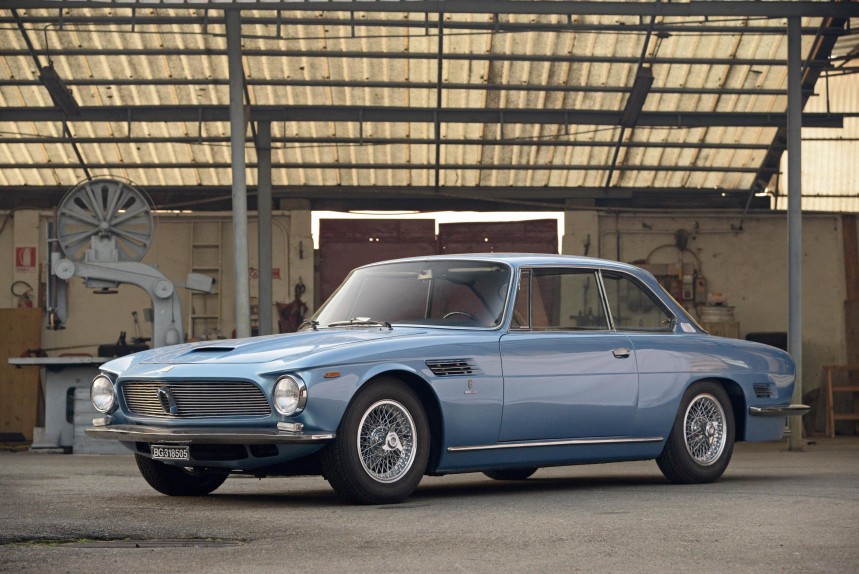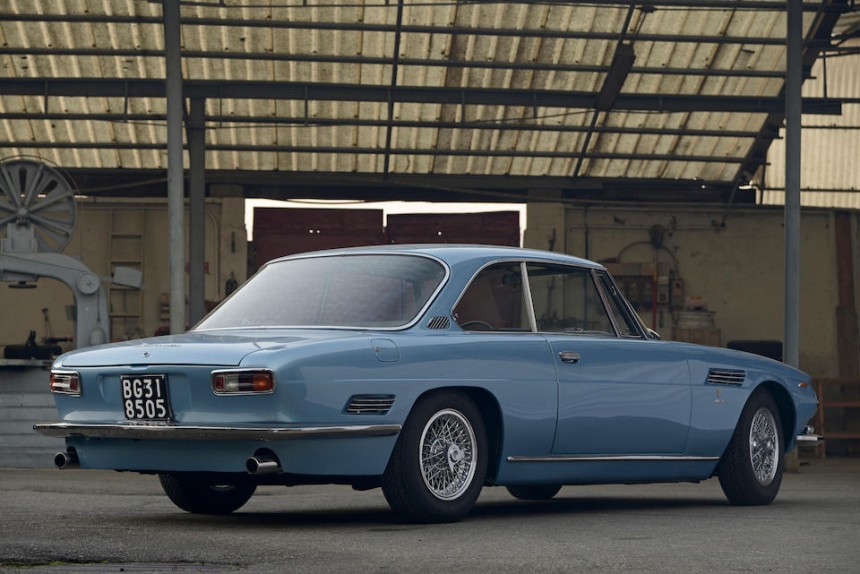In the aftermath of World War II, an Italian engineer by the name of Renzo Rivolta decided that motorbikes would make him a tidy profit. Rivolta then switched to microcars, hitting it big with the Isetta that was produced under license by many companies, including BMW. Renzo then eyed life-sized cars, which brings us to the car we’re covering today.
1961 is the year ex-Ferrari engineer Giotto Bizzarrini was approached by Rivolta to develop a sporty and luxurious grand tourer. Baptized IR after the Italian automaker’s name, this project wouldn’t have been possible without Giorgetto Giugiaro, then on the payroll of coachbuilder Bertone.
Iso Rivolta was officially founded in 1962, a different legal entity born from the ashes of Iso Autoveicoli that gave us the Isetta. That summer, a prototype of the IR 300 was presented to Italian journalists to attract some deposits. Presented in production-ready form later that year, the IR 300 entered production in the spring of 1963 with a rather ambitious target.
Renzo expected 1,500 units to be sold on a yearly basis. He was badly off the mark, but you’ll have to wait a little to find out how many were delivered through 1970. Spoiler alert: fewer than 800 units had been completed.
The IR 300 is rocking a Giotto Bizzarrini-designed steel chassis with boxed side members. Measuring 2,700 millimeters (approximately 106.3 inches) from the front axle to the rear axle, the four-seat grand tourer is gifted with unequal double wishbones up front and a de Dion arrangement out back, complemented by a Watt’s linkage and a couple of trailing arms. A front anti-roll bar and coil-sprung hydraulic shocks on all corners are used.
To address the proverbial elephant in the room, the 100-liter (26.4 -gallon) fuel tank feeds a General Motors-designed V8 through a Carter-supplied carburetor. The dual-barrel unit sits atop a 5.4-liter small block, the legendary 327 from the 4.000-inch bore family. Introduced in 1962, this lump was capable of 225 to 383 horsepower in street-legal applications. The version used in the IR 300, dubbed L75, pumps out 300 metric ponies.
Torque isn’t shabby either. From a 10.5:1 compression ratio, the all-iron engine is much obliged to deliver 360 pound-feet (488 Nm) at 3,200 revolutions per minute. Iso Rivolta offered a more powerful option, baptized IR 340, that makes 300 ponies of the metric variety. Its torque rating is higher as well, namely 343 pound-feet (465 Nm) at 4,000 rpm.
The main differences between the IR 300 and IR 340 can be summed up rather simply. The hotter camshaft, mechanical valve lifters instead of hydraulic tappets, and 11.25:1 compression ratio are responsible for the aforementioned bumps. Both variants of the Italo-American gran turismo are fitted with a BorgWarner four-speed manual and a Salisbury diff.
11.75- and 11.25-inch disc brakes from Dunlop are tasked with stopping this off-radar collectible, which tips the scales at 1,590 kilograms (3,505 pounds). 100 kilometers per hour (62 miles per hour) are dealt with in 8.4 seconds for the IR 300, while the IR 340 needs 7.9 seconds. The maximum speed also differs, namely 218 kph (135 mph) and 228 kph (142 mph).
A handful of cars were spruced up with pokier 327 mills, which gained them the 350 moniker. Later in the IR’s life, Iso Rivolta upsized the rear brake discs. Center-lock Borrani wire wheels, measuring 15 by 6.4 inches, were supplied together with Pirelli Cinturato rubber. Later models came with chrome-garnished alloy wheels as standard, while the Borranis soldiered on as an option. To boot, Renzo’s company sweetened the deal with an optional five-speed manual instead of the standard four, and a three-speed automatic.
From the standpoint of exterior design, the Giugiaro-penned IR stands out with the help of a beautiful hood scoop and a pair of inverted eyebrows above the circular headlamps. The alloy front grille integrates a horseshoe-styled centerpiece, and wraparound screens are featured front and rear.
The well-equipped IR originally shipped with Connolly leather upholstery and black vinyl for the dashboard top. A wood-rimmed steering wheel frames a 300-kph (186-mph) speedometer, a tachometer that goes to 7,000 revolutions per minute, and an oil pressure gauge right between them.
Teak veneer and electric windows were also standard. In terms of extras, air conditioning opens the list, followed by Armstrong Selectaride dampers with four-way electric adjustment, fog lights, a radio, and three final ratios. Production of the IR came to a screeching halt in 1970, with only 797 examples finished. Of those, only 167 were produced in IR 340 flavor.
Iso Rivolta was officially founded in 1962, a different legal entity born from the ashes of Iso Autoveicoli that gave us the Isetta. That summer, a prototype of the IR 300 was presented to Italian journalists to attract some deposits. Presented in production-ready form later that year, the IR 300 entered production in the spring of 1963 with a rather ambitious target.
Renzo expected 1,500 units to be sold on a yearly basis. He was badly off the mark, but you’ll have to wait a little to find out how many were delivered through 1970. Spoiler alert: fewer than 800 units had been completed.
The IR 300 is rocking a Giotto Bizzarrini-designed steel chassis with boxed side members. Measuring 2,700 millimeters (approximately 106.3 inches) from the front axle to the rear axle, the four-seat grand tourer is gifted with unequal double wishbones up front and a de Dion arrangement out back, complemented by a Watt’s linkage and a couple of trailing arms. A front anti-roll bar and coil-sprung hydraulic shocks on all corners are used.
Torque isn’t shabby either. From a 10.5:1 compression ratio, the all-iron engine is much obliged to deliver 360 pound-feet (488 Nm) at 3,200 revolutions per minute. Iso Rivolta offered a more powerful option, baptized IR 340, that makes 300 ponies of the metric variety. Its torque rating is higher as well, namely 343 pound-feet (465 Nm) at 4,000 rpm.
The main differences between the IR 300 and IR 340 can be summed up rather simply. The hotter camshaft, mechanical valve lifters instead of hydraulic tappets, and 11.25:1 compression ratio are responsible for the aforementioned bumps. Both variants of the Italo-American gran turismo are fitted with a BorgWarner four-speed manual and a Salisbury diff.
11.75- and 11.25-inch disc brakes from Dunlop are tasked with stopping this off-radar collectible, which tips the scales at 1,590 kilograms (3,505 pounds). 100 kilometers per hour (62 miles per hour) are dealt with in 8.4 seconds for the IR 300, while the IR 340 needs 7.9 seconds. The maximum speed also differs, namely 218 kph (135 mph) and 228 kph (142 mph).
From the standpoint of exterior design, the Giugiaro-penned IR stands out with the help of a beautiful hood scoop and a pair of inverted eyebrows above the circular headlamps. The alloy front grille integrates a horseshoe-styled centerpiece, and wraparound screens are featured front and rear.
The well-equipped IR originally shipped with Connolly leather upholstery and black vinyl for the dashboard top. A wood-rimmed steering wheel frames a 300-kph (186-mph) speedometer, a tachometer that goes to 7,000 revolutions per minute, and an oil pressure gauge right between them.
Teak veneer and electric windows were also standard. In terms of extras, air conditioning opens the list, followed by Armstrong Selectaride dampers with four-way electric adjustment, fog lights, a radio, and three final ratios. Production of the IR came to a screeching halt in 1970, with only 797 examples finished. Of those, only 167 were produced in IR 340 flavor.






































